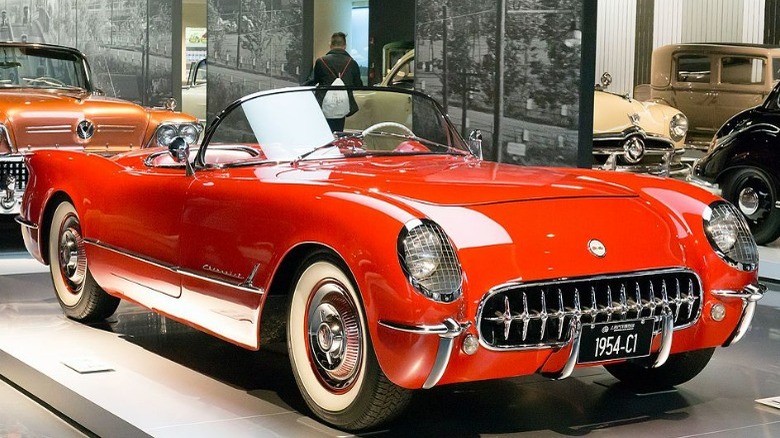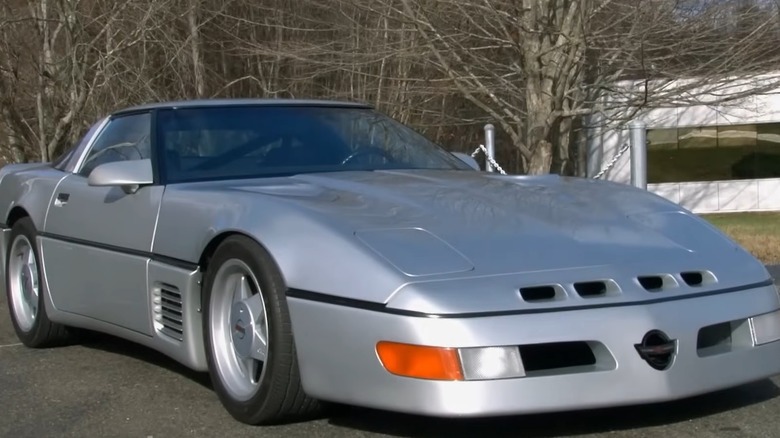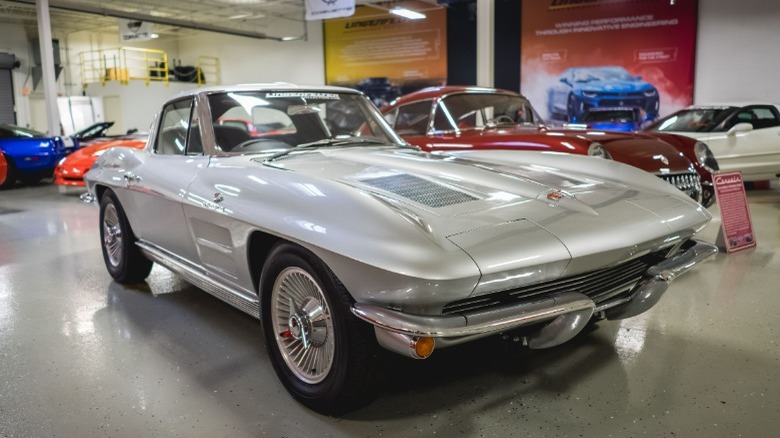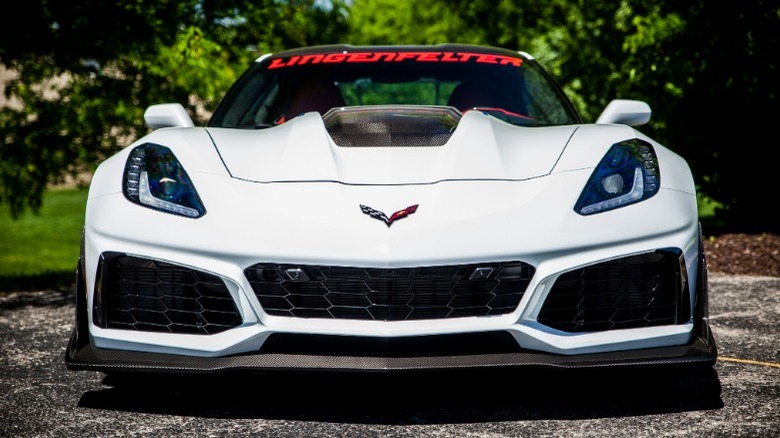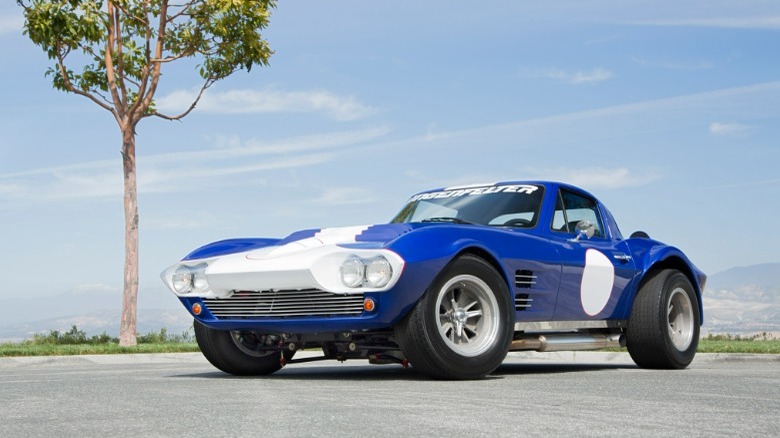5 Of The Most Incredible Corvettes In Ken Lingenfelter's Collection
Corvettes began as two-speed sports cars lacking in 'sportiness.' Chevrolet debuted the vehicle at the 1953 Motorama show and then hastily produced 300 more for consumers, selling only a little over half (183 in total).
By 1962, Chevrolet was phasing out the first generation, but performance and style had come leaps and bounds. The '61 Corvette showcased the car's classic quad taillight layout, and under the hood for 1962, it carried a 5.4L V8 engine that produced 360 horsepower. Now in its eighth generation, the car is a testament to innovation and performance driving.
The Corvette's history coincides with the life and career of Ken Lingenfelter, the son of a GM company man and cousin to John Lingenfelter, a champion NHRA drag racing star with 13 national wins. Ken told Car and Driver in 2018 that he would go into the factory with his dad after dinner to see the flurry of activity and magic of automobile production. "I saw the split-window Corvette in '63 – I was 10 years old," he adds when reminiscing on visits on family days to the Tech Center. "That car did something to me. I know it sounds silly, but it kind of paved the way for the future," he concludes. Today, Ken Lingenfelter owns hundreds of cars, a collection that Automotive Magazine calls "one of the world's largest collections of muscle and performance cars." And it's underpinned by these amazing Corvettes that bring him back to that sense of childish wonder.
A 1954, first generation Corvette: A Mule
"This is a collection of cars I like," Ken Lingenfelter tells Automotive Magazine while standing in his impressive garage filled with classic automobiles. One standout Corvette has to be his 1954 "Mule," a first generation 'Vette and the model that served as a testing car for Zora Arkus Duntov. The '54 Mule was the first Corvette to include a V8 engine, a 265 CI.
Lingenfelter's C1 Corvette has undergone a few modifications to make it even more personal. His model includes a tail fin, for instance. The C1 Corvettes from '54 were built using the same fiberglass body with which the vehicle was introduced, alongside a steel frame and chassis features. The car's engine is a 3.8L OHV Inline-six "Blue Flame" and utilizes water cooling and normally aspirated construction. It produced 150/155 horsepower and 223 pound-feet of torque.
[Featured image by Morio via Wikimedia Commons | Cropped and scaled | CC BY-SA 4.0]
The 1988 C4 Sledgehammer driven by John Lingenfelter
Another profoundly personal vehicle in Ken Lingenfelter's collection is the 1988 C4 "Sledgehammer" driven by his cousin John before he died in a racing accident. The vehicle isn't just a special model for Lingenfelter; it's also a unique piece of automotive history because John took it on a 1,500-mile round trip to the Transportation Research Center's track in Ohio. During this drive, he smashed the road car speed record, accelerating the Sledgehammer Corvette to 254.76 miles per hour.
The silver Corvette was a one-off production model with 880 brake horsepower and 772 pound-feet of torque. The vehicle is outfitted with a 5.7L Twin Turbo V8 engine, and in 1989, the original gearbox was swapped out for a ZF six-speed manual transmission. Paul Deutschman designed the vehicle's unique body stylings, and later Callaway Corvette models would sport the same aesthetic features.
A 1963 split-window Corvette
This one is a rarity among Corvettes, and the exact type Ken Lingenfelter saw as a 10-year-old. This split-window feature makes it all the more remarkable as a piece of his collection, even as the car turns heads on its own. The '63 Corvette is a part of the first production year for the second generation 'Vettes.
The car utilizes Peter Brock's split-window design, a standout feature of the model. On top of that, the hood includes a thin center ridge that looks like someone fused a missile to the car. The vehicle drives like a missile, too, powered by a fuel injected 327 CI V8 engine that produces 360 horsepower. The engine is paired with a T-10 four-speed manual transmission, and in Lingenfelter's, the original engine and transmission can be found intact within the car.
The split-window Corvettes are a unique collector's item because the feature was removed in the '64 design, making it a one-off feature that hasn't resurfaced. This is because the segment of the car body that ran between the two windows acted as a point of obstruction for rear visibility and ended up becoming a notable design flaw.
2019 ZR1 Corvette
In a 2018 interview with Car and Driver, Ken Lingenfelter told John Pearley Huffman, "my new ZR1 we haven't touched. Yet." All told, Lingenfelter owned three ZR1s at the time. Of a total production run of 2,953 (and just 828 manual transmission models) ZR1s in 2019, the only year this particular car was built, that's saying something. In speaking with Hagerty's Kyle Smith in 2020, he notes that he typically keeps one of a series like this unchanged and drives the vehicle regularly to identify weaknesses that can be overcome on the workshop floor.
A 6.2L LT5 Supercharged V8 engine powers his white ZR1, producing 755 horsepower and 715 pound-feet of torque. His model was factory upgraded for $16,000, including a Factory installed carbon fiber rear wing. The ZR1 is the fastest production Corvette ever built, topping out at 202 miles per hour and doing 0-60 in a blazing 2.9 seconds. His model is driven with a seven-speed Tremec TR-6070 manual transmission.
Superformance Grand Sport Corvette
The Superformance reboot of the Grand Sport brings together the early history of Corvette design with the high-output manufacturing and tuning that producers are capable of today. The Grand Sport model was developed by Chevrolet's chief engineer Zora Arkus Duntov in 1962.
The goal was to produce 125 racers to win the 24 Hours of LeMans' GT class race. However, the project was terminated after just five vehicles were finished in a pilot production run. This makes the Grand Sport a legendary effort by the "Father of the Corvette," Arkus Duntov, and one that never fully saw the light of day. Even so, Grand Sports are often touted as some of the coolest Corvettes around.
Ken Lingenfelter's Superformance Grand Sport has been perfectly tuned in his workshop. The Corvette utilizes a 427ci Lingenfelter LS7-based engine with 603 horsepower and a 5 to 1 compression ratio. Many of the internal components were purpose-built to improve the Corvette as well. The cylinder heads are a Lingenfelter CNC ported LS3 design, and the air cleaner system was also built with Lingenfelter workshop CNC tools. This Corvette takes a piece of the car's history and triples down on modern enhancements to deliver something worthy of being listed on any "incredible Corvettes" collection.

